Superconducting Accelerator Magnets Based on High-Temperature Superconducting Bi-2212 Round Wires
Abstract
:1. Introduction
2. Superconducting Accelerator Magnets: Complexity and Requirements
3. The Development of Bi-2212 into a Magnet-Grade Conductor: Materials Challenges and Breakthroughs
4. Subscale Magnets Based on Racetrack Coils
5. Magnet Challenges beyond Jc
5.1. The Ability of Rutherford Cables to Handle Transverse Loads
5.2. Heat Treatment of Long-Length Magnets for Predictable High Performance
5.3. Field Quality and Effective Filament Size
5.4. Rutherford Cables Optimization and Engineering
5.5. Quench Detection and Protection: Is There a New Operation Paradigm?
6. Canted-Cosine-Theta Accelerator Magnet Design and Technology
6.1. Constraints in the Transverse Dimension
6.2. Constraints in the Longitudinal Dimension
7. A Roadmap and Synergetic Developments
7.1. A US Magnet Development Program Roadmap
- Build high-field Bi-2212 CCT magnets at LBNL. (1) Build 2.4 T dipole magnets using the BIN5 design. These short models serve as a fast turnaround R&D vehicle for testing technology variants. (2) Build a 5 T dipole demonstration magnet (BIN6 in Table 1) to meet the US MDP R&D goal. It has 48 turns per layer and uses 64 m of cable. It has a straight section of 11 mm and uses 5 kg of the Bi-2212 conductor. (3) Perform hybrid magnet tests. The first experiment is to test the 2.4 T BIN5 inside the Nb3Sn CCT5, an 8 T, 1 m long CCT dipole magnet that is immediately available with a bore of 90 mm. The second experiment is to test the BIN6 inside a new 11 T, 120 mm bore Nb3Sn dipole magnet being developed by the US MDP and available in 2022; the target total dipole field in the bore is >14 T. The goal of these tests are to (a) examine whether the magnet can survive mechanical stresses at 9 T and then ~14 T, (b) determine whether the Bi-2212 CCT magnets will remain quench training free, (c) examine the impacts of electromagnetic coupling and the degree of mechanical interactions between two magnets on quench detection and protection (e.g., flux jumps in Nb3Sn may induce voltages spikes in HTS). Such tests will run with two separate electrical power circuits, and (4) measure and model field quality.
- Explore a stress-management cosine-theta (SMCT) concept for both Nb3Sn [90] and Bi-2212 [91] at the Fermilab. Similar to the CCT design, the SMCT design, proposed by Zlobin et al. [90,91], also transfers the Lorentz forces of the coil to an internal structure, thus limiting the transverse load to Rutherford cables. The program is still being developed. The proposal [91] is to test a two-layer SMCT Bi-2212 coil inside either a dipole mirror structure HFDM with a background field provided by two-layer Nb3Sn coils or a MDPCT structure with a background field provided by four-layer Nb3Sn coils. Powering the Bi-2212 insert and Nb3Sn outsert independently could produce a dipole field of 12.5–13.5 T in the HFDM structure and 18–19 T in the MDPCT structure. As the first step of the program, powering the Bi-2212 and Nb3Sn coils in the series would still produce a dipole field of 9.5 and 12 T in the HFDM and MDPCT structures, respectively.
- Develop a new OPHT facility at the NHMFL. The coils that have been reacted so far have used the DELTECH OPHT furnace at the NHMFL (Figure 2d) that has a heat treatment zone of 45 cm and a diameter of 14 cm. NHMFL/FSU is constructing a larger 50 bar OPHT furnace, RENEGADE, with a homogeneity zone of 1 m long and 0.25 m in diameter. The furnace is expected to be commissioned in 2020.
- Explore a Rutherford cable based high-field solenoid concept at the NHMFL. Compared to a single-strand magnet, Rutherford cable-based solenoids have the benefits of reduced risks against point defects in a long length strand, improved stability, and easier quench protection. The program leverages on a new NHMFL test facility with a 14 T solenoid with a bore of 161 mm and an independent power supply circuit of 7.2 kA. The first step is to demonstrate the feasibility of stress management and quench protection with an insert made from a 9 m long Rutherford cable used in the CCT BIN5aOL and BIN5bOL; the insert generates 2.7 T in a background field of 14 T. If successful, the technologies developed can be extended to generate a total field of 25–30 T.
- Continue the wire R&D collaboration between the US MDP and wire and powder industry to continue the parallel development of the Bi-2212 conductor. The targeted wire JE in coils, or the smallest JE achieved in a Tp of ±5 °C is 1000 A/mm2 at 4.2 K and 20 T, ~35% higher than the JE value of the strand PMM170123 shown in Figure 5, and ~15% lower than the best JE value of the strand PMM170123 shown in Figure 1.
7.2. Bi-2212 for >25 T User Magnets and 1.3 GHz NMR Spectrometers
8. Conclusions
Author Contributions
Funding
Acknowledgments
Conflicts of Interest
References
- Rossi, L. Superconductivity: Its role, its success and its setbacks in the Large Hadron Collider of CERN. Supercond. Sci. Technol. 2010, 23, 34001. [Google Scholar] [CrossRef] [Green Version]
- Mitchell, N.; Bessette, D.; Gallix, R.; Jong, C.; Knaster, J.; Libeyre, P.; Sborchia, C.; Simon, F. The ITER Magnet System. IEEE Trans. Appl. Supercond. 2008, 18, 435–440. [Google Scholar] [CrossRef]
- Alonso, J.R.; Antaya, T.A. Superconductivity in Medicine. Rev. Accel. Sci. Technol. 2012, 5, 227–263. [Google Scholar] [CrossRef]
- Winn, B.L.; Broholm, C.; Bird, M.; Breneman, B.C.; Coffey, M.; Cutler, R.I.; Duckworth, R.C.; Erwin, R.; Hahn, S.; Hernandez, Y.; et al. Ultra-High Field Magnets for X-Ray and Neutron Scattering using High Temperature Superconductors; Oak Ridge National Laboratory: Oak Ridge, TN, USA, 2017.
- Sorbom, B.; Ball, J.; Palmer, T.; Mangiarotti, F.; Sierchio, J.; Bonoli, P.; Kasten, C.; Sutherland, D.; Barnard, H.; Haakonsen, C.; et al. ARC: A compact, high-field, fusion nuclear science facility and demonstration power plant with demountable magnets. Fusion Eng. Des. 2015, 100, 378–405. [Google Scholar] [CrossRef] [Green Version]
- Maeda, H.; Yamazaki, T.; Nishiyama, Y.; Hamada, M.; Hashi, K.; Shimizu, T.; Suematsu, H.; Yanagisawa, Y. Development of Super-High-Field NMR Operated Beyond 1 GHz Using High-Temperature Superconducting Coils. eMagRes 2016, 5, 1109–1120. [Google Scholar] [CrossRef]
- Larbalestier, D.C.; Gurevich, A.; Feldmann, D.M.; Polyanskii, A. High-Tc superconducting materials for electric power applications. Nature 2001, 414, 368–377. [Google Scholar] [CrossRef]
- Foltyn, S.R.; Civale, L.; MacManus-Driscoll, J.L.; Jia, Q.X.; Maiorov, B.; Wang, H.; Maley, M. Materials science challenges for high-temperature superconducting wire. Nat. Mater. 2007, 6, 631–642. [Google Scholar] [CrossRef] [PubMed]
- Van Nugteren, J.; Kirby, G.A.; De Rijk, G.; Rossi, L.; Kate, H.H.J.T.; Dhalle, M.M.J. Study of a 5 T Research Dipole Insert-Magnet Using an Anisotropic ReBCO Roebel Cable. IEEE Trans. Appl. Supercond. 2014, 25, 1–5. [Google Scholar] [CrossRef] [Green Version]
- Kirby, G.A.; Van Nugteren, J.; Ballarino, A.; Bottura, L.; Chouika, N.; Clement, S.; Datskov, V.; Fajardo, L.; Fleiter, J.; Gauthier, R.; et al. Accelerator-Quality HTS Dipole Magnet Demonstrator Designs for the EuCARD-2 5-T 40-mm Clear Aperture Magnet. IEEE Trans. Appl. Supercond. 2014, 25, 1–5. [Google Scholar] [CrossRef] [Green Version]
- Rossi, L.; Badel, A.; Bajko, M.; Ballarino, A.; Bottura, L.; Dhalle, M.M.J.; Durante, M.; Fazilleau, P.; Fleiter, J.; Goldacker, W.; et al. The EuCARD-2 Future Magnets European Collaboration for Accelerator-Quality HTS Magnets. IEEE Trans. Appl. Supercond. 2014, 25, 1–7. [Google Scholar] [CrossRef]
- Fleiter, J.; Ballarino, A.; Bottura, L.; Goldacker, W.; Kario, A. Characterization of Roebel Cables for Potential Use in High-Field Magnets. IEEE Trans. Appl. Supercond. 2014, 25, 1–4. [Google Scholar] [CrossRef]
- Van Der Laan, D.C.; Weiss, J.D.; Noyes, P.; Trociewitz, U.P.; Godeke, A.; Abraimov, D.; Larbalestier, D.C. Record current density of 344 A mm−2 at 4.2 K and 17 T in CORC® accelerator magnet cables. Supercond. Sci. Technol. 2016, 29, 55009. [Google Scholar] [CrossRef] [Green Version]
- Wang, X.; Caspi, S.; Dietderich, D.R.; Ghiorso, W.B.; A Gourlay, S.; Higley, H.C.; Lin, A.; O Prestemon, S.; Van Der Laan, D.C.; Weiss, J.D. A viable dipole magnet concept with REBCO CORC® wires and further development needs for high-field magnet applications. Supercond. Sci. Technol. 2018, 31, 045007. [Google Scholar] [CrossRef] [Green Version]
- Wang, X.; Dietderich, D.R.; DiMarco, J.; Ghiorso, W.B.; A Gourlay, S.; Higley, H.C.; Lin, A.; O Prestemon, S.; Van Der Laan, D.C.; Weiss, J.D. A 1.2 T canted cosθ dipole magnet using high-temperature superconducting CORC® wires. Supercond. Sci. Technol. 2019, 32, 075002. [Google Scholar] [CrossRef] [Green Version]
- Wang, X.; Gourlay, S.A.; Prestemon, S. Dipole Magnets Above 20 Tesla: Research Needs for a Path via High-Temperature Superconducting REBCO Conductors. Instruments 2019, 3, 62. [Google Scholar] [CrossRef] [Green Version]
- Larbalestier, D.C.; Jiang, J.; Trociewitz, U.P.; Kametani, F.; Scheuerlein, C.; Dalban-Canassy, M.; Matras, M.; Chen, P.; Craig, N.C.; Lee, P.J.; et al. Isotropic round-wire multifilament cuprate superconductor for generation of magnetic fields above 30 T. Nat. Mater. 2014, 13, 375–381. [Google Scholar] [CrossRef]
- Marken, K.; Miao, H.; Meinesz, M.; Czabaj, B.; Hong, S. BSCCO-2212 conductor development at oxford superconducting technology. IEEE Trans. Appl. Supercond. 2003, 13, 3335–3338. [Google Scholar] [CrossRef]
- Miao, H.; Marken, K.R.; Meinesz, M.; Czabaj, B.; Hong, S. Development of round multifilament Bi-2212/Ag wires for high field magnet applications. IEEE Trans. Appl. Supercond. 2005, 15, 2554–2557. [Google Scholar] [CrossRef]
- Gourlay, S.A.; Prestemon, S.O.; Zlobin, A.V.; Cooley, L.; Larbalestier, D. The US Magnet Development Program Plan; Lawrence Berkeley National Laboratory: Berkeley, CA, USA, 2016. [Google Scholar]
- Asner, A.; Perin, R.; Wenger, S.; Zerobin, F. First Nb3Sn, 1m Long Superconducting Dipole Model Magnets for LHC Break the 10 Tesla Field Threshold. In Proceedings of the 11th International Conference on Magnet Technology (MT-11); Springer: Dordrecht, Germany, 1990; pp. 36–41. [Google Scholar]
- Scanlan, R.; Dietderich, D. Progress and plans for the U.S. HEP conductor development program. IEEE Trans. Appl. Supercond. 2003, 13, 1536–1541. [Google Scholar] [CrossRef]
- Caspi, S.; Gourlay, S.; Hafalia, R.; Lietzke, A.; Oneill, J.; Taylor, C.; Jackson, A. The use of pressurized bladders for stress control of superconducting magnets. IEEE Trans. Appl. Supercond. 2001, 11, 2272–2275. [Google Scholar] [CrossRef] [Green Version]
- Ferracin, P.; Ambrosio, G.; Anerella, M.; Bajas, H.; Bajko, M.; Bordini, B.; Bossert, R.; Bourcey, N.; Cheng, D.W.; Chlachidze, G.; et al. The HL-LHC Low-β Quadrupole Magnet MQXF: From Short Models to Long Prototypes. IEEE Trans. Appl. Supercond. 2019, 29, 1–9. [Google Scholar] [CrossRef] [Green Version]
- Muratore, J.; Amm, K.; Anerella, M.; Ambrosio, G.; Apollinari, G.; Baldini, M.; Carcagno, R.H.; Chlachidze, G.; Cheng, D.W.; Feher, S.; et al. Test Results of the First Two Full-Length Prototype Quadrupole Magnets for the LHC Hi-Lumi Upgrade. IEEE Trans. Appl. Supercond. 2020, 30, 1–5. [Google Scholar] [CrossRef]
- Zlobin, A.V.; Novitski, I.; Barzi, E.; Kashikhin, V.V.; Carmichael, J.; Caspi, S.; Chlachidze, G.; Krave, S.T.; Orozco, C.; Schoerling, D.; et al. Development and First Test of the 15 T Nb3Sn Dipole Demonstrator MDPCT1. IEEE Trans. Appl. Supercond. 2020, 30, 1–5. [Google Scholar] [CrossRef]
- Tollestrup, A.; Todesco, E. The Development of Superconducting Magnets for Use in Particle Accelerators: From the Tevatron to the LHC. Rev. Accel. Sci. Technol. 2008, 1, 185–210. [Google Scholar] [CrossRef] [Green Version]
- Rossi, L.; Bottura, L. Superconducting Magnets for Particle Accelerators. Rev. Accel. Sci. Technol. 2012, 5, 51–89. [Google Scholar] [CrossRef] [Green Version]
- Mess, K.-H.; Schmüser, P.; Wolff, S. Superconducting Accelerator Magnets; World Scientific: Singapore, 1996. [Google Scholar]
- Schoerling, D.; Zlobin, A.V. Nb3Sn Accelerator Magnets: Designs, Technologies and Performance; Springer Nature: Cham, Switzerland, 2019. [Google Scholar]
- Bottura, L.; Godeke, A. Superconducting Materials and Conductors: Fabrication and Limiting Parameters. Rev. Accel. Sci. Technol. 2012, 5, 25–50. [Google Scholar] [CrossRef] [Green Version]
- Heine, K.; Tenbrink, J.; Thöner, M. High-field critical current densities in Bi2Sr2CaCu2O8+x/Ag wires. Appl. Phys. Lett. 1989, 55, 2441–2443. [Google Scholar] [CrossRef]
- Kametani, F.; Jiang, J.; Matras, M.; Abraimov, D.; Hellstrom, E.E.; Larbalestier, D.C. Comparison of growth texture in round Bi2212 and flat Bi2223 wires and its relation to high critical current density development. Sci. Rep. 2015, 5, 8285. [Google Scholar] [CrossRef]
- Oz, Y.; Davis, D.; Jiang, J.; Hellstrom, E.; Larbalestier, D. Influence of Twist Pitch on Hysteretic Losses and Transport Jc in Overpressure Processed Bi-2212 Round Wires. In In Proceedings of the International Cryogenic Materials Conference, Madison, WI, USA, 9–13 July 2017. [Google Scholar]
- Marken, K.; Miao, H.; Meinesz, M.; Czabaj, B.; Hong, S. Progress in Bi-2212 Wires for High Magnetic Field Applications. IEEE Trans. Appl. Supercond. 2006, 16, 992–995. [Google Scholar] [CrossRef]
- Li, P.; Ye, L.; Jiang, J.; Shen, T. RRR and thermal conductivity of Ag and Ag-0.2 wt.%Mg alloy in Ag/Bi-2212 wires. IOP Conf. Ser. Mater. Sci. Eng. 2015, 102, 012027. [Google Scholar] [CrossRef] [Green Version]
- Bonura, M.; Avitabile, F.; Barth, C.; Jiang, J.; Larbalestier, D.C.; Fête, A.; Leo, A.; Bottura, L.; Senatore, C. Very-high thermal and electrical conductivity in overpressure-processed Bi2Sr2CaCu2O8+x wires. Mater. Res. Express 2018, 5, 056001. [Google Scholar] [CrossRef] [Green Version]
- Shen, T.; Jiang, J.; Hellstrom, E. Powder-in-tube Superconducting Wires: Fabrication, Properties, Applications, and Challenges. In Applied Superconductivity: Handbook on Devices and Applications; Seidel, P., Ed.; John Wiley & Sons: Weinheim, Germany, 2015. [Google Scholar]
- Shen, T. Processing, microstructure, and critical current density of silver-sheathed Bi2Sr2CaCu2Ox multifilamentary round wire. Ph.D. Thesis, The Florida State University, Tallahassee, FL, USA, 2010. [Google Scholar]
- Shen, T.; Jiang, J.; Kametani, F.; Trociewitz, U.P.; Larbalestier, D.C.; Schwartz, J.; Hellstrom, E.E. Filament to filament bridging and its influence on developing high critical current density in multifilamentary Bi2Sr2CaCu2Ox round wires. Supercond. Sci. and Technol. 2009, 23, 025009. [Google Scholar] [CrossRef]
- Kametani, F.; Shen, T.; Jiang, J.; Scheuerlein, C.; Malagoli, A.; Di Michiel, M.; Huang, Y.; Miao, H.; A Parrell, J.; Hellstrom, E.; et al. Bubble formation within filaments of melt-processed Bi2212 wires and its strongly negative effect on the critical current density. Supercond. Sci. Technol. 2011, 24, 75009. [Google Scholar] [CrossRef] [Green Version]
- Scheuerlein, C.; Di Michiel, M.; Scheel, M.; Jiang, J.; Kametani, F.; Malagoli, A.; Hellstrom, E.; Larbalestier, D.C. Void and phase evolution during the processing of Bi-2212 superconducting wires monitored by combined fast synchrotron micro-tomography and x-ray diffraction. Supercond. Sci. Technol. 2011, 24, 115004. [Google Scholar] [CrossRef]
- Malagoli, A.; Lee, P.J.; Ghosh, A.K.; Scheuerlein, C.; Di Michiel, M.; Jiang, J.; Trociewitz, U.P.; Hellstrom, E.; Larbalestier, D.C. Evidence for length-dependent wire expansion, filament dedensification and consequent degradation of critical current density in Ag-alloy sheathed Bi-2212 wires. Supercond. Sci. Technol. 2013, 26, 55018. [Google Scholar] [CrossRef] [Green Version]
- Jiang, J.; Starch, W.L.; Hannion, M.; Kametani, F.; Trociewitz, U.P.; Hellstrom, E.; Larbalestier, D.C. Doubled critical current density in Bi-2212 round wires by reduction of the residual bubble density. Supercond. Sci. Technol. 2011, 24, 82001. [Google Scholar] [CrossRef]
- Shen, T.; Ghosh, A.; Cooley, L.D.; Jiang, J. Role of internal gases and creep of Ag in controlling the critical current density of Ag-sheathed Bi2Sr2CaCu2Ox wires. J. Appl. Phys. 2013, 113, 213901. [Google Scholar] [CrossRef] [Green Version]
- Kikuchi, M.; Kato, T.; Ohkura, K.; Ayai, N.; Fujikami, J.; Fujino, K.; Kobayashi, S.; Ueno, E.; Yamazaki, K.; Yamade, S.; et al. Recent development of drastically innovative BSCCO wire (DI-BISCCO). Phys. C Supercond. 2006, 445, 717–721. [Google Scholar] [CrossRef]
- Bock, J.; Preisler, E. Preparation of single phase 2212 bismuth strontium calcium cuprate by melt processing. Solid State Commun. 1989, 72, 453–458. [Google Scholar] [CrossRef]
- Jiang, J.; Francis, A.; Alicea, R.; Matras, M.; Kametani, F.; Trociewitz, U.P.; Hellstrom, E.E.; Larbalestier, D.C. Effects of Filament Size on Critical Current Density in Overpressure Processed Bi-2212 Round Wire. IEEE Trans. Appl. Supercond. 2017, 27, 1–4. [Google Scholar] [CrossRef]
- Jiang, J.; Bradford, G.; Hossain, S.I.; Brown, M.; Cooper, J.; Miller, E.; Huang, Y.; Miao, H.; Parrell, J.A.; White, M.; et al. High-performance Bi-2212 round wires made with recent powders. IEEE Trans. Appl. Supercond. 2019, 29, 1–5. [Google Scholar] [CrossRef]
- Shen, T.; Bosque, E.; Davis, D.; Jiang, J.; White, M.; Zhang, K.; Higley, H.; Turqueti, M.; Huang, Y.; Miao, H.; et al. Stable, predictable and training-free operation of superconducting Bi-2212 Rutherford cable racetrack coils at the wire current density of 1000 A/mm2. Sci. Rep. 2019, 9, 10170. [Google Scholar] [CrossRef] [PubMed] [Green Version]
- Miao, H.; Marken, K.R.; Meinesz, M.; Czabaj, B.; Hong, S.; Rikel, M.O.; Bock, J. Studies of precursor composition effect on Jc in Bi-2212/Ag wires and tapes. AIP Conf. Proc. 2006, 824, 673–682. [Google Scholar] [CrossRef]
- Rikel, M.; Arsac, S.; Soileux, E.; Ehrenberg, J.; Bock, J.; Marken, K.; Miao, H.; Bruzek, C.-E.; Pavard, S.; Matsumoto, A.; et al. Effect of composition on the melting behaviour of Bi2212-Ag conductors. J. Phys. Conf. Ser. 2006, 43, 51–54. [Google Scholar] [CrossRef] [Green Version]
- Li, P.; Naderi, G.; Schwartz, J.; Shen, T. On the role of precursor powder composition in controlling microstructure, flux pinning, and the critical current density of Ag/Bi2Sr2CaCu2Ox conductors. Supercond. Sci. Technol. 2017, 30, 35004. [Google Scholar] [CrossRef]
- Hafalia, R.; Caspi, S.; Chiesa, L.; Coccoli, M.; Dietderich, D.; Gourlay, S.; Lietzke, A.; O’Neill, J.; Sabbi, G.; Scanlan, R. An approach for faster high field magnet technology development. IEEE Trans. Appl. Supercond. 2003, 13, 1258–1261. [Google Scholar] [CrossRef]
- Benjegerdes, R.; Bish, P.; Byford, D.; Caspi, S.; Dietderich, D.; Gourlay, S.; Hafalia, R.; Hannaford, R.; Higley, H.; Jackson, A.; et al. Fabrication and test results of a high field, Nb3Sn superconducting racetrack dipole magnet. In Proceedings of the PACS2001, 2001 Particle Accelerator Conference (Cat. No.01CH37268), Chicago, IL, USA, 18–22 June 2001; Volume 1, pp. 208–210. [Google Scholar]
- Godeke, A.; Acosta, P.; Cheng, D.; Dietderich, D.R.; Mentink, M.G.T.; O Prestemon, S.; Sabbi, G.; Meinesz, M.; Hong, S.; Huang, Y.; et al. Wind-and-react Bi-2212 coil development for accelerator magnets. Supercond. Sci. Technol. 2010, 23, 34022. [Google Scholar] [CrossRef] [Green Version]
- Zhang, K.; Higley, H.; Ye, L.; Gourlay, S.; Prestemon, S.; Shen, T.; Bosque, E.; English, C.L.; Jiang, J.Y.; Kim, Y.; et al. Tripled critical current in racetrack coils made of Bi-2212 Rutherford cables with overpressure processing and leakage control. Supercond. Sci. Technol. 2018, 31, 105009. [Google Scholar] [CrossRef] [Green Version]
- Chen, P.; Trociewitz, U.P.; Dalban-Canassy, M.; Jiang, J.; Hellstrom, E.E.; Larbalestier, D.C. Performance of titanium oxide–polymer insulation in superconducting coils made of Bi-2212/Ag-alloy round wire. Supercond. Sci. Technol. 2013, 26, 075009. [Google Scholar] [CrossRef]
- Lu, J.; McGuire, D.; Kandel, H.; Xin, Y.; Chen, P.; Jiang, J.; Trociewitz, U.; Hellstrom, E.; Larbalestier, D.C. Ceramic Insulation of Bi2Sr2CaCu2O8-x Round Wire for High-Field Magnet Applications. IEEE Trans. Appl. Supercond. 2016, 26, 1. [Google Scholar] [CrossRef]
- Kandel, H.; Lü, J.; Jiang, J.; Chen, P.; Matras, M.; Craig, N.; Trociewitz, U.P.; Hellstrom, E.; Larbalestier, D.C. Development of TiO2 electrical insulation coating on Ag-alloy sheathed Bi2Sr2CaCu2O8-x round-wire. Supercond. Sci. Technol. 2015, 28, 35010. [Google Scholar] [CrossRef]
- Shen, T.; Li, P.; Jiang, J.; Cooley, L.D.; Tompkins, J.C.; McRae, D.; Walsh, R. High strength kiloampere Bi2Sr2CaCu2Ox cables for high-field magnet applications. Supercond. Sci. Technol. 2015, 28, 065002. [Google Scholar] [CrossRef]
- Marchevsky, M.; Gourlay, S.A. Acoustic thermometry for detecting quenches in superconducting coils and conductor stacks. Appl. Phys. Lett. 2017, 110, 012601. [Google Scholar] [CrossRef] [Green Version]
- Ravaioli, E.; Davis, D.; Marchevsky, M.; Sabbi, G.; Shen, T.; Verweij, A.; Zhang, K. A new quench detection method for HTS magnets: Stray-capacitance change monitoring. Phys. Scr. 2019, 95, 015002. [Google Scholar] [CrossRef]
- Ye, L.; Li, P.; Jaroszynski, J.; Schwartz, J.; Shen, T. Strain control of composite superconductors to prevent degradation of superconducting magnets due to a quench: I. Ag/Bi2Sr2CaCu2Ox multifilament round wires. Supercond. Sci. Technol. 2016, 30, 25005. [Google Scholar] [CrossRef] [Green Version]
- Godeke, A.; Hartman, M.H.C.; Mentink, M.G.T.; Jiang, J.; Matras, M.; Hellstrom, E.; Larbalestier, D.C. Critical current of dense Bi-2212 round wires as a function of axial strain. Supercond. Sci. Technol. 2015, 28, 32001. [Google Scholar] [CrossRef]
- Bjoerstad, R.; Scheuerlein, C.; O Rikel, M.; Ballarino, A.; Bottura, L.; Jiang, J.; Matras, M.; Sugano, M.; Hudspeth, J.; Di Michiel, M. Strain induced irreversible critical current degradation in highly dense Bi-2212 round wire. Supercond. Sci. Technol. 2015, 28, 62002. [Google Scholar] [CrossRef] [Green Version]
- Cheggour, N.; Florida State University, Tallahassee, FL, USA. Personal communication, 2020.
- Cheggour, N.; Lu, X.F.; Holesinger, T.G.; Stauffer, T.C.; Jiang, J.; Goodrich, L.F. Reversible effect of strain on transport critical current in Bi2Sr2CaCu2O8+x superconducting wires: A modified descriptive strain model. Supercond. Sci. Technol. 2011, 25, 15001. [Google Scholar] [CrossRef] [Green Version]
- Dietderich, D.; Hasegawa, T.; Aoki, Y.; Scanlan, R. Critical current variation of Rutherford cable of Bi-2212 in high magnetic fields with transverse stress. Physica C 2000, 341, 2599–2600. [Google Scholar] [CrossRef] [Green Version]
- Shen, T.; Li, P.; Ye, L. Heat treatment control of Bi-2212 coils: I. Unravelling the complex dependence of the critical current density of Bi-2212 wires on heat treatment. Cryogenics 2018, 89, 95–101. [Google Scholar] [CrossRef]
- Shen, T.; Jiang, J.; Kametani, F.; Trociewitz, U.P.; Larbalestier, D.C.; Hellstrom, E.E. Heat treatment control of Ag-i2Sr2CaCu2Ox multifilamentary round wire: Investigation of time in the melt. Supercond. Sci. Technol. 2011, 24, 115009. [Google Scholar] [CrossRef]
- Tollestrup, A. Temperature Profile Measurements During Heat Treatment of BSCCO 2212 Coils; Fermi National Accelerator Laboratory: Batavia, IL, USA, 2011. [Google Scholar]
- Dalban-Canassy, M.; A Myers, D.; Trociewitz, U.P.; Jiang, J.; Hellstrom, E.; Viouchkov, Y.; Larbalestier, D.C. A study of the local variation of the critical current in Ag-alloy clad, round wire Bi2Sr2CaCu2O8+xmulti-layer solenoids. Supercond. Sci. Technol. 2012, 25, 115015. [Google Scholar] [CrossRef]
- Miao, H.; Huang, Y.; Hong, S.; Gerace, M.; Parrell, J. Bi-2212 round wire development for high field applications. J. Phys. Conf. Ser. 2014, 507, 022020. [Google Scholar] [CrossRef] [Green Version]
- Scanlan, R. The evolution of tooling, techniques, and quality control for accelerator dipole magnet cables. IEEE Trans. Appl. Supercond. 1993, 3, 842–849. [Google Scholar] [CrossRef]
- Barzi, E.; Turrioni, D.; Kikuchi, A.; Lamm, M.; Rusy, A.; Yamada, R.; Zlobin, A.V. BSCCO-2212 Wire and Cable Studies. AIP Conf. Proc. 2008, 986, 431–438. [Google Scholar] [CrossRef]
- Barzi, E.; Lombardo, V.; Tollestrup, A.; Turrioni, D. Study of Effects of Transverse Deformation in BSCCO-2212 Wires. IEEE Trans. Appl. Supercond. 2011, 21, 2808–2811. [Google Scholar] [CrossRef]
- Collings, E.; Sumption, M.D.; Majoros, M.; Wang, X.; Dietderich, D.R. Effects of Core Type, Placement, and Width on the Estimated Interstrand Coupling Properties of QXF-Type Nb3Sn Rutherford Cables. IEEE Trans. Appl. Supercond. 2015, 25, 1–5. [Google Scholar] [CrossRef]
- Hasegawa, T.; Ohtani, N.; Koizumi, T.; Aoki, Y.; Nagaya, S.; Hirano, N.; Motowidlo, L.; Sokolowski, R.; Scanlan, R.; Dietderich, D.; et al. Improvement of superconducting properties of Bi-2212 round wire and primary test results of large capacity Rutherford cable. IEEE Trans. Appl. Supercond. 2001, 11, 3034–3037. [Google Scholar] [CrossRef]
- Collings, E.; Scanlan, R.; Dietderich, D.; Motowidlo, L.; Sumption, M.D. Low coupling loss core-strengthened Bi:2212/Ag Rutherford cables. IEEE Trans. Appl. Supercond. 1999, 9, 758–761. [Google Scholar] [CrossRef]
- Caspi, S.; Borgnolutti, F.; Brouwer, L.; Cheng, D.; Dietderich, D.R.; Félice, H.; Godeke, A.; Hafalia, R.; Martchevskii, M.; Prestemon, S.; et al. Canted–Cosine–Theta Magnet (CCT)—A Concept for High Field Accelerator Magnets. IEEE Trans. Appl. Supercond. 2014, 24, 1–4. [Google Scholar] [CrossRef]
- Brouwer, L.N. Canted-cosine-theta superconducting accelerator magnets for high energy physics and ion beam cancer therapy. Ph.D. Thesis, University of California, Berkeley, CA, USA, 2015. [Google Scholar]
- Fajardo, L.G.; Brouwer, L.; Caspi, S.; Gourlay, S.; Prestemon, S.; Shen, T.; Gourlay, S. Designs and Prospects of Bi-2212 Canted-Cosine-Theta Magnets to Increase the Magnetic Field of Accelerator Dipoles Beyond 15 T. IEEE Trans. Appl. Supercond. 2018, 28, 1–5. [Google Scholar] [CrossRef]
- Auchmann, B.; Brouwer, L.; Caspi, S.; Gao, J.; Montenero, G.; Negrazus, M.; Rolando, G.; Sanfilippo, S. Electromechanical Design of a 16-T CCT Twin-Aperture Dipole for FCC. IEEE Trans. Appl. Supercond. 2018, 28, 1–5. [Google Scholar] [CrossRef] [Green Version]
- Caspi, S.; Brouwer, L.; Lipton, T.; Hafalia, A.; Prestemon, S.; Dietderich, D.; Félice, H.; Wang, X.; Rochepault, E.; Godeke, A.; et al. Design of an 18-T Canted Cosine–Theta Superconducting Dipole Magnet. IEEE Trans. Appl. Supercond. 2014, 25, 1–5. [Google Scholar] [CrossRef]
- Brouwer, L.; Caspi, S.; Hafalia, R.; Hodgkinson, A.; Prestemon, S.; Robin, D.; Wan, W. Design of an Achromatic Superconducting Magnet for a Proton Therapy Gantry. IEEE Trans. Appl. Supercond. 2017, 27, 1–6. [Google Scholar] [CrossRef] [Green Version]
- Brouwer, L.; Caspi, S.; Edwards, K.; Godeke, A.; Hafalia, R.; Hodgkinson, A.; Huggins, A.; Myers, C.; Myers, S.; Schillo, M.; et al. Design and test of a curved superconducting dipole magnet for proton therapy. Nucl. Instrum. Methods Phys. Res. Sect. A Accel. Spectromet. Detect. Assoc. Equip. 2020, 957, 163414. [Google Scholar] [CrossRef]
- Godeke, A.; Brouwer, L.N.; Caspi, S.; Dietderich, D.R.; Gourlay, S.A.; Hafalia, R.R.; Heys, N.I.; Higley, H.C.; Lipton, T.M.; Swanson, J.H.; et al. Bi-2212 Canted-Cosine-Theta Coils for High-Field Accelerator Magnets. IEEE Trans. Appl. Supercond. 2014, 25, 1–4. [Google Scholar] [CrossRef]
- Fajardo, L.G.; Brouwer, L.; Caspi, S.; Hafalia, A.; Hernikl, C.D.; Prestemon, S.; Shen, T.; Bosque, E.; English, C.L.; Hafalia, R. Fabrication of Bi-2212 Canted-Cosine-Theta Dipole Prototypes. IEEE Trans. Appl. Supercond. 2019, 29, 1–5. [Google Scholar] [CrossRef] [Green Version]
- Zlobin, A.; Carmichael, J.; Kashikhin, V.; Novitski, I. Conceptual Design of a 17 T Nb3Sn Accelerator Dipole Magnet. In Proceedings of the 9th International Particle Accelerator Conference (IPAC 2018), WEPML027, Vancouver, BC, Canada, 29 April–4 May 2018. [Google Scholar]
- Zlobin, A.; Barzi, E.; Novitski, I. Conceptual Design of the Fermilab HTS Dipole Insert Based on Bi2212 Rutherford Cable; Fermi National Accelerator Lab (FNAL): Batavia, IL, USA, 2020. [Google Scholar]
- Matras, M.R.; Jiang, J.; Larbalestier, D.C.; Hellstrom, E.E. Understanding the densification process of Bi2Sr2CaCu2Ox round wires with overpressure processing and its effect on critical current density. Supercond. Sci. Technol. 2016, 29, 105005. [Google Scholar] [CrossRef]
- Matras, M.R.; Jiang, J.; Trociewitz, U.P.; Larbalestier, D.C.; E Hellstrom, E. Process to densify Bi2Sr2CaCu2Ox round wire with overpressure before coil winding and final overpressure heat treatment. Supercond. Sci. Technol. 2020, 33, 025010. [Google Scholar] [CrossRef]
- Hossain, I.; Jiang, J.; Matras, M.; Trociewitz, U.P.; Lu, J.; Kametani, F.; Larbalestier, D.C.; Hellstrom, E. Effect of sheath material and reaction overpressure on Ag protrusions into the TiO2 insulation coating of Bi-2212 round wire. IOP Conf. Series: Mater. Sci. Eng. 2017, 279, 12021. [Google Scholar] [CrossRef] [Green Version]
- Chen, P.; Trociewitz, U.P.; Davis, D.S.; Bosque, E.S.; Hilton, D.K.; Kim, Y.; Abraimov, D.V.; Starch, W.L.; Jiang, J.; Hellstrom, E.E.; et al. Development of a persistent superconducting joint between Bi-2212/Ag-alloy multifilamentary round wires. Supercond. Sci. Technol. 2016, 30, 025020. [Google Scholar] [CrossRef] [PubMed]
- Davis, D.S. Quench Protection of Bi2Sr2CaCu2O8+x High Temperature Superconducting Magnets. Ph.D.Thesis, The Florida State University, Tallahassee, FL, USA, 2019. [Google Scholar]
- Chen, P.; Trociewitz, U.P.; Lu, J.; Bosque, E.S.; Jiang, J.; Hellstrom, E.E.; Larbalestier, D.C. Experimental Study of Potential Heat Treatment Issues of Large Bi-2212 Coils. IEEE Trans. Appl. Supercond. 2017, 27, 1–5. [Google Scholar] [CrossRef] [PubMed]
- Brown, M.; Bosque, E.; McRae, D.; Walsh, R.; Jiang, J.; Hellstrom, E.E.; Kim, Y.; Trociewitz, U.; Otto, A.; Larbalestier, D.C. Tensile properties and critical current strain limits of reinforced Bi-2212 conductors for high field magnets. IOP Conf. Ser. Mater. Sci. Eng. 2017, 279, 012022. [Google Scholar] [CrossRef] [PubMed]
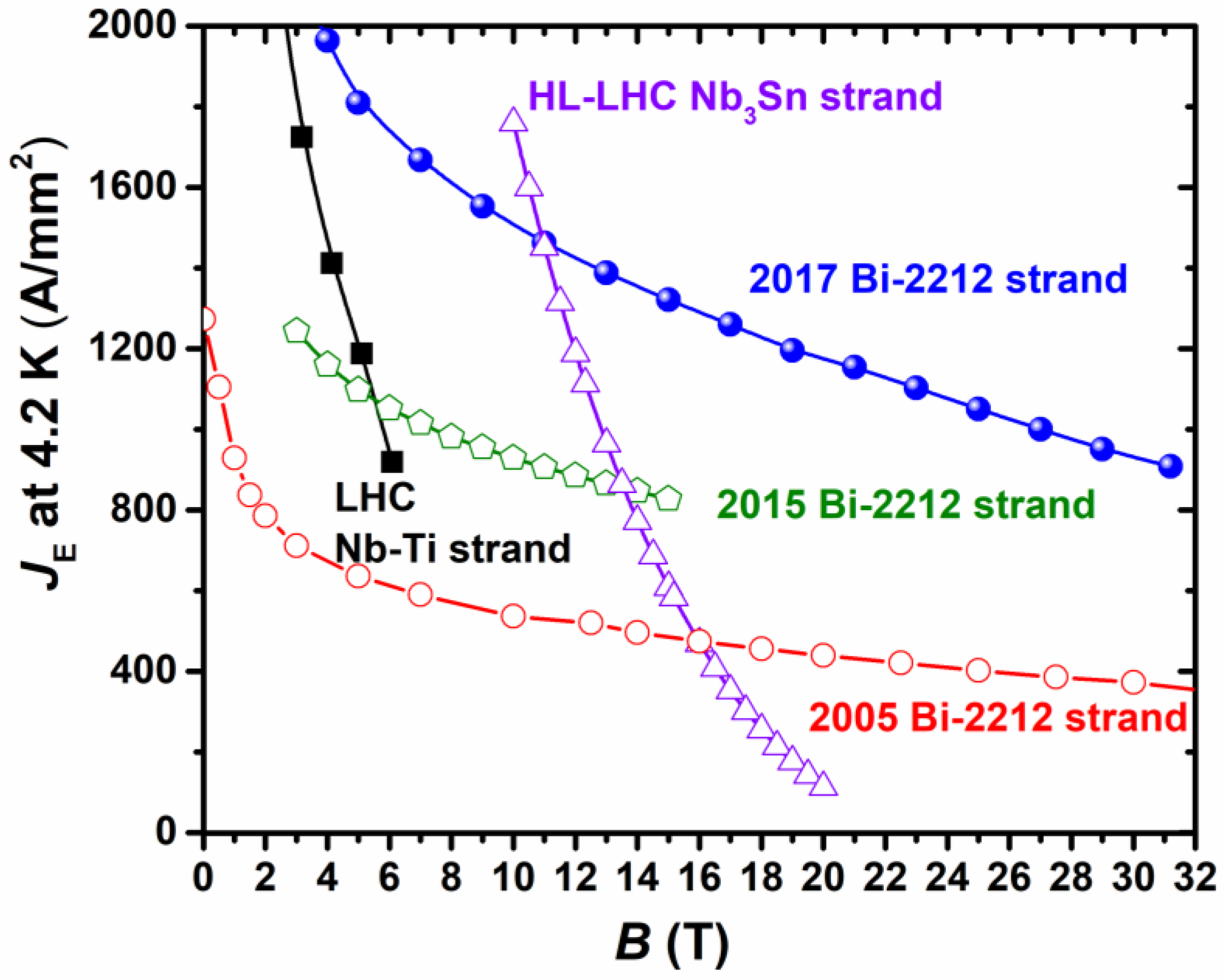
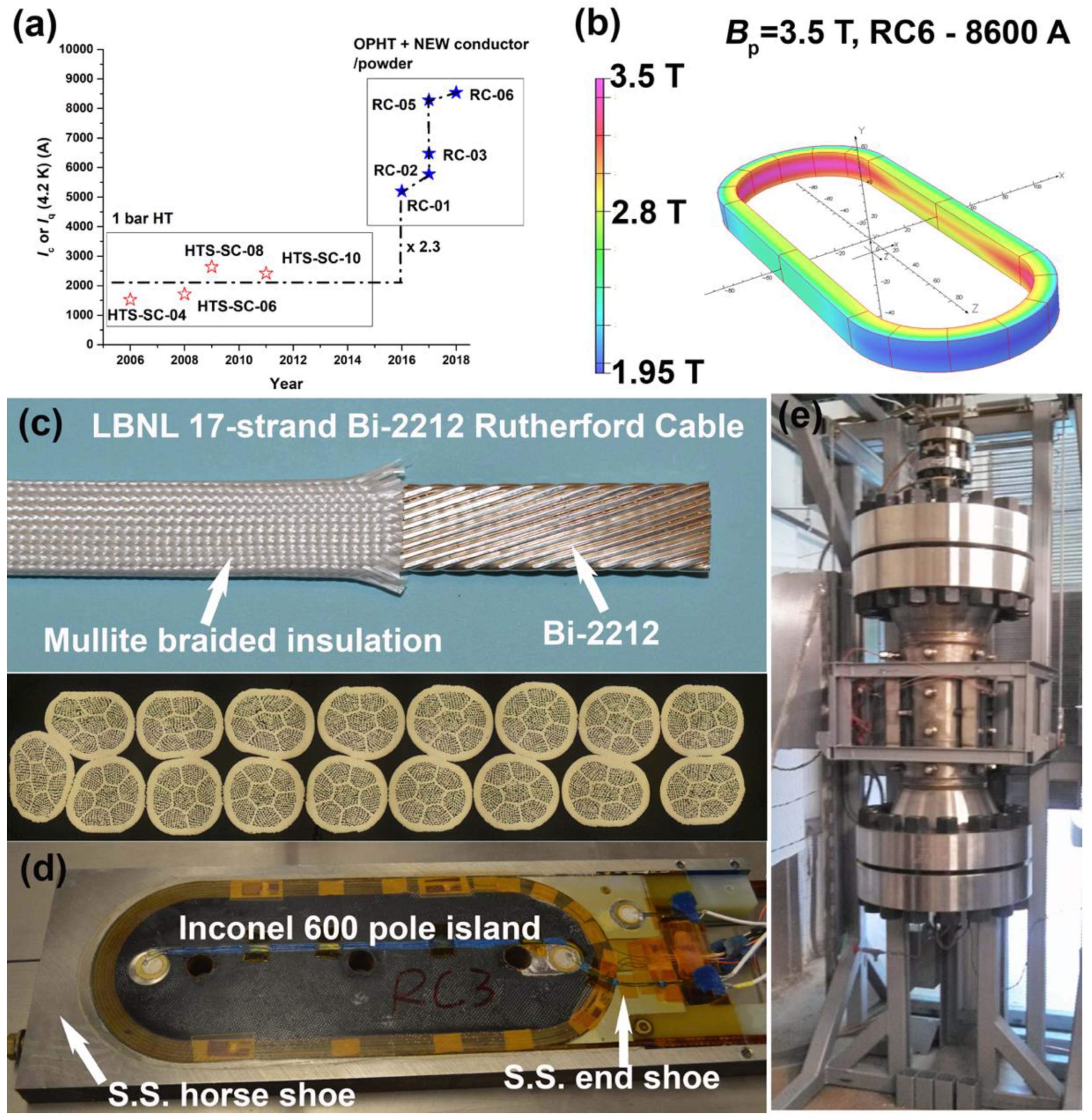
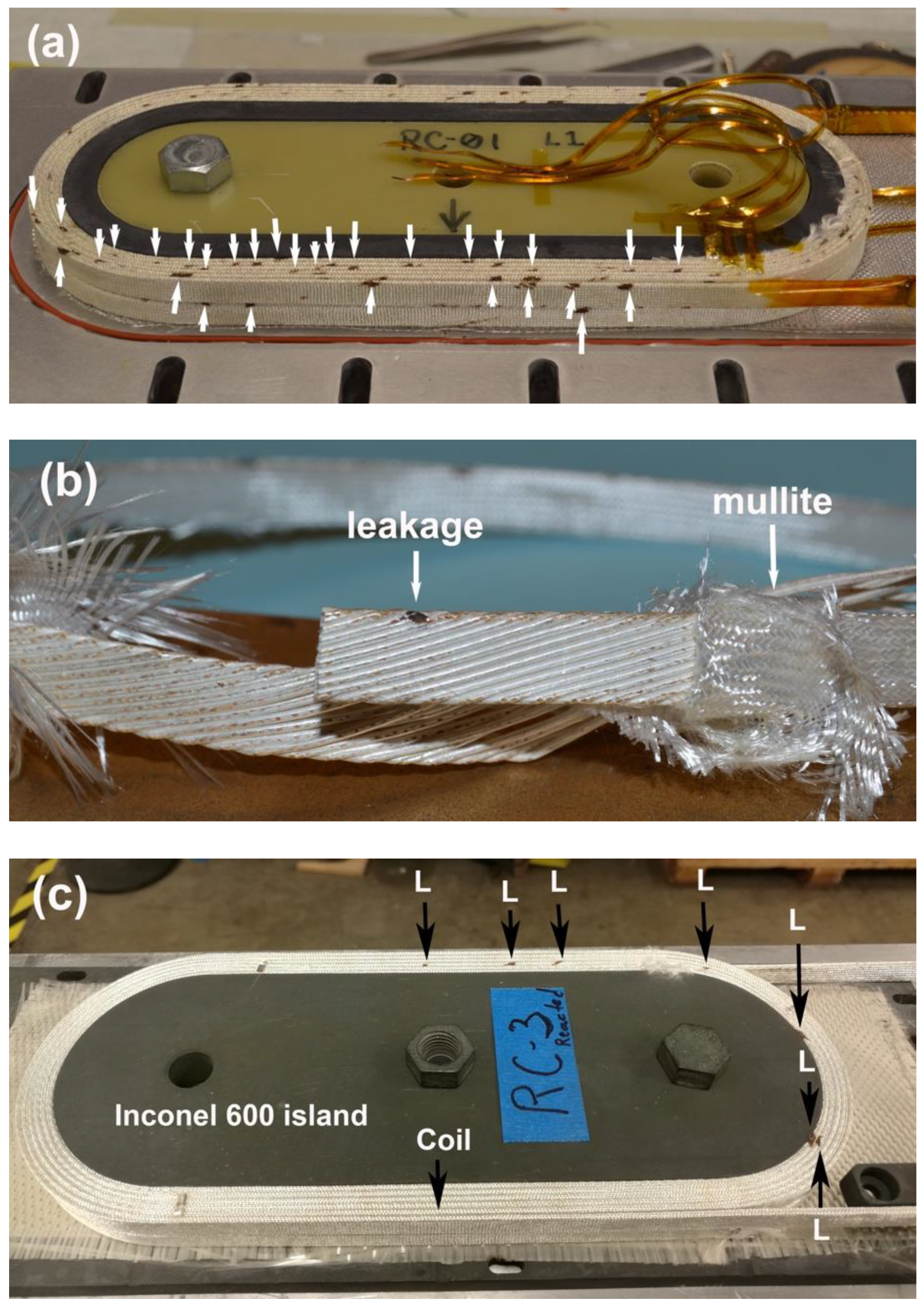
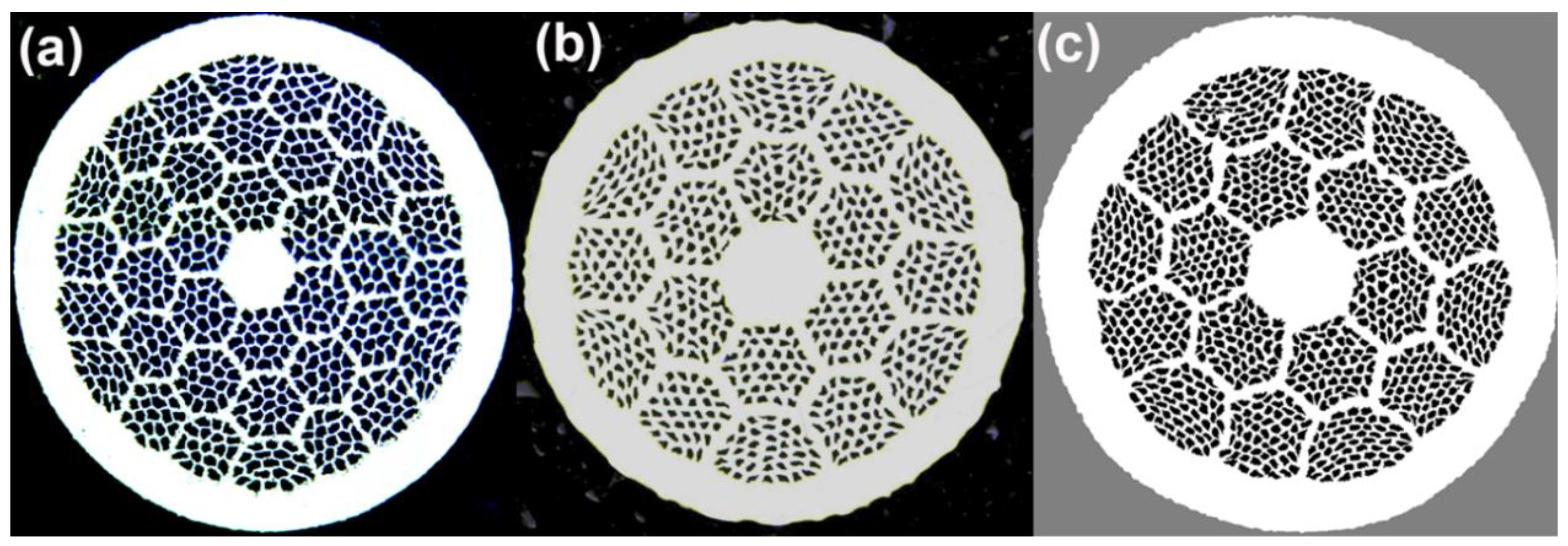



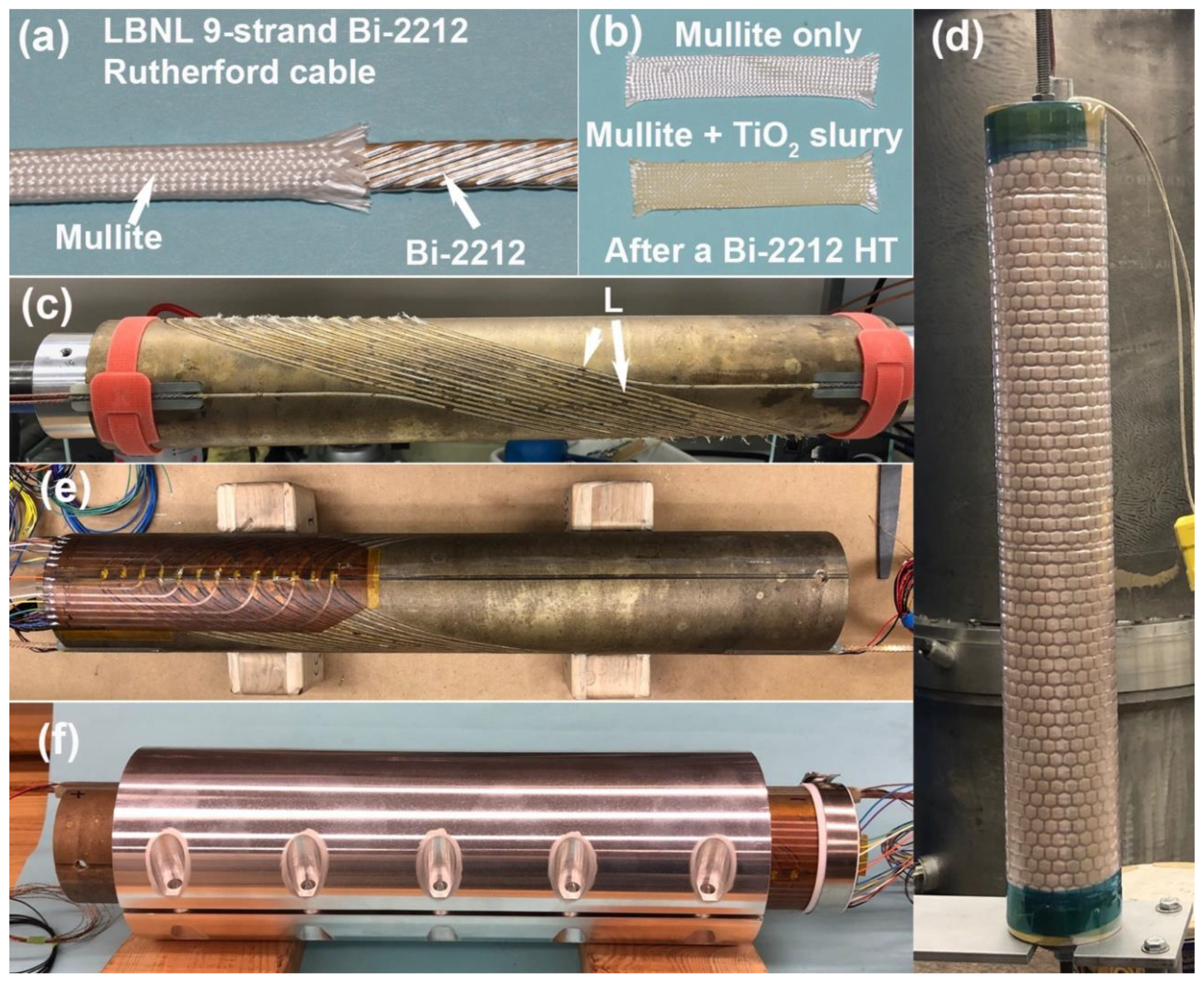
| Coil (Year) | Conductor | Mandrel | Insulation | Heat Treatment | Performance |
|---|---|---|---|---|---|
| BIN1 (2014) | Single strand | Inconel 600 | Mullite sleeves | 1 bar HT | Extensive leakage |
| BIN2IL (2014) | 6 + 1 round cable | 654 | Mullite sleeves | 1 bar HT | Iq~1.477 kA at 4.3 K, Peak field Bp on conductor = 0.48 T, B1 = 0.29 T in the bore. Significant deformation after reaction. |
| BIN3 | - | - | - | - | Not manufactured. |
| BIN4 (2017) | 9-strand Rutherford cable | 954 | Mullite sleeves | - | Electrically shorted to mandrel after winding. Not reacted. |
| BIN5aOL (2018) | Same as above | 954 | TiO2 slurry on mullite sleeves | OPHT | Bore diameter = 51.5 mm. SSL = 6.48 kA. Iq~4.02 kA at 4.2 K, Bp on conductor = 1.3 T, B1 = 0.71 T in the bore, b3 = 1000 units and about 30 units at r = 13 mm due to persistent currents at I = 1 kA. Small deformation after reaction. Epoxy impregnated. |
| BIN5bOL (2018) | Same as above | 954 | TiO2 slurry on mullite sleeve | OPHT with Inconel 600 strongback | Transferred to a Bluestone 3D-printed mandrel after reaction. Iq~3.1 kA at 4.2 K. |
| BIN5c (2020) | Same as above | 954 | TiO2 slurry on cable, and on mullite sleeve | OPHT | In fabrication. SSL = 5.85 kA. Bbore = 2.4 T. |
| BIN6 (2021) | 17-strand Rutherford cable | 954 | Same as above | OPHT | In design. SSL = 9 kA, Bbore = 5 T. Bore = 50 mm. OD = 100 mm. |
© 2020 by the authors. Licensee MDPI, Basel, Switzerland. This article is an open access article distributed under the terms and conditions of the Creative Commons Attribution (CC BY) license (http://creativecommons.org/licenses/by/4.0/).
Share and Cite
Shen, T.; Garcia Fajardo, L. Superconducting Accelerator Magnets Based on High-Temperature Superconducting Bi-2212 Round Wires. Instruments 2020, 4, 17. https://doi.org/10.3390/instruments4020017
Shen T, Garcia Fajardo L. Superconducting Accelerator Magnets Based on High-Temperature Superconducting Bi-2212 Round Wires. Instruments. 2020; 4(2):17. https://doi.org/10.3390/instruments4020017
Chicago/Turabian StyleShen, Tengming, and Laura Garcia Fajardo. 2020. "Superconducting Accelerator Magnets Based on High-Temperature Superconducting Bi-2212 Round Wires" Instruments 4, no. 2: 17. https://doi.org/10.3390/instruments4020017
APA StyleShen, T., & Garcia Fajardo, L. (2020). Superconducting Accelerator Magnets Based on High-Temperature Superconducting Bi-2212 Round Wires. Instruments, 4(2), 17. https://doi.org/10.3390/instruments4020017





